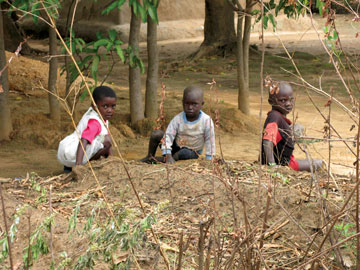|
NEWS NOTES
Mining leaves nasty legacy in Zambia
 Gary Krieger |
| In Kabwe, Zambia, young children play in contaminated areas covered with dust containing lead, cadmium, arsenic and other heavy metals, leading to epidemics of lead poisoning. |
The city of Kabwe in central Zambia is one of the most poisonous places on Earth. From the early 1900s to 1994, Kabwe hosted Africa’s largest lead mining and smelting operation, which left the place so contaminated that the Blacksmith Institute, a New York-based environmental group, ranked Kabwe among the world’s 10 worst polluted places in 2007. The dry dirt on the streets that residents sweep daily is laced with sky-high concentrations of lead, and as a result, tens of thousands of Kabwe’s 300,000 residents suffer from severe lead poisoning, according to Gary Krieger, a toxicologist at the University of Colorado at Denver, who conducted medical studies in the region. “We estimate that there are 30,000 lead-poisoned children in this area, based on U.S. EPA and other international standards,” he said at the annual meeting of the Geological Society of America in Denver in October.
But so far, Kabwe has attracted minimal remediation funding or international scrutiny relative to the magnitude of the ongoing health problems, Krieger said. After the mine shut down in 1994, “[it] just sat there with little or nothing done,” he said — with only minimal attempts at remediation or stopping unsuspecting residents from scavenging contaminated mine materials. Over the past few years, however, several institutions, including the World Bank and the Nordic Development Fund, have allocated money to educate residents about the dangers and to begin site cleanup.
The Kabwe mine, one of the largest sustained mining pollution legacies in the world, probably hasn’t received more international attention because of one simple fact: It’s a state-owned enterprise, Krieger said. “Such enterprises don’t attract much scrutiny and protest from nongovernmental organizations.” Because government institutions usually do not have funds set aside for things like cleanup or toxicology studies, they are not targets of protest like privately owned mining companies are, he said. Private companies “provide a big fat target,” he said, citing Newmont Mining Corporation’s Buyat Bay project in Indonesia as an example. The company’s tailings disposal processes, which allegedly involved dumping mercury into the bay, caused an outcry followed by lawsuits that so far have incurred the company more than $30 million in legal costs alone, Krieger said. “The Buyat Bay gold mine became a cause célèbre attracting international media coverage despite the well-documented lack of any scientific evidence that health or environmental impacts actually occurred,” he said. Studies that looked at villagers near Buyat Bay actually showed that people in the control group had higher levels of mercury than the target group at Buyat Bay, “but mercury levels of both populations were vastly lower than any international standard,” he said.
In contrast, thousands of blood samples that Krieger and his colleagues collected from children and adolescents in Kabwe revealed lead levels off the charts. “All of them would fail current U.S. Environmental Protection Agency or European Union standards to a spectacular degree,” he said.
Today, the Copperbelt Environment Project (a World Bank-funded project run by the Zambian government) is implementing remediation and public outreach measures, such as teaching people how to avoid lead exposure and developing educational materials and public information centers to address the impacts of lead on Kabwe’s residents.
Comparing the public reaction to the problems in Zambia and Indonesia holds a cautionary lesson for the mining industry, Krieger said. “I would argue that when doing risk assessment for mining operations the actual quantification of hazard is, frankly, largely irrelevant,” he said. “The key thing is outrage. And whether there is actually something there or whether it’s entirely manufactured doesn’t matter. But when there is outrage, it’s big trouble.”

 Subscribe
Subscribe


